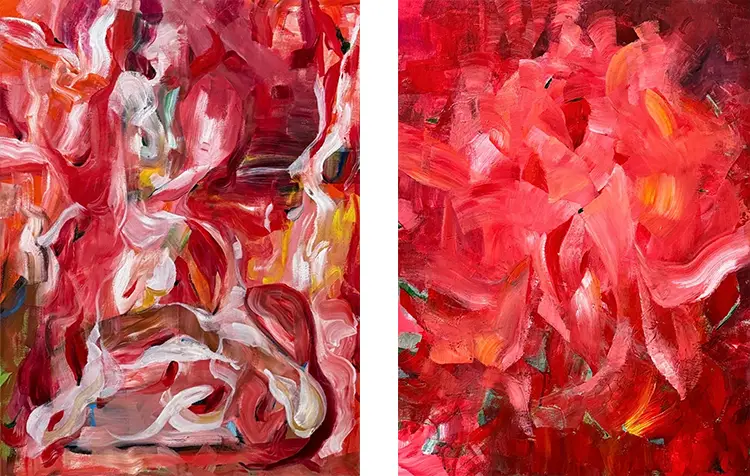“Art does not need to solve problems; it can coexist with chaos and uncertainty and still hold meaning.”
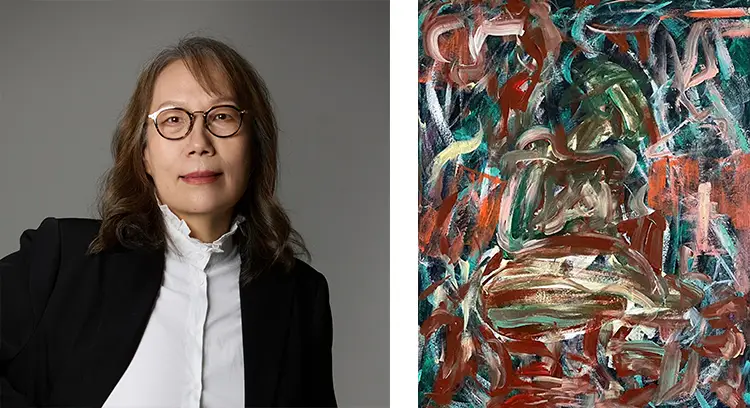
Shifting Grounds: The Cross-Cultural Pulse of Yanhua Feng’s Practice
Yanhua Feng’s artistic voice emerges from a confluence of traditions, geographies, and evolving states of awareness. Born in China and now based in San Francisco, she navigates her practice through studios in Vancouver and Beijing, engaging with painting and installation as fluid extensions of life energy. Her creative journey reflects a life lived across borders, a condition that permeates her work with a sense of continuous motion and transformation. Trained at the Central Academy of Arts and Design—now Tsinghua University’s Academy of Arts and Design—Feng was initially grounded in a formal artistic discipline that emphasized structure. Yet, within this rigorous foundation, she discovered an essential duality: the interplay between precision and freedom, constraint and release.
The pivotal shift in her trajectory occurred after relocating abroad with her daughter. Stepping away from the familiar offered her a rare moment of pause, enabling her to reflect deeply on the essence of art and its function in a complex, often contradictory world. Rather than seeking resolution, Feng came to embrace art’s ability to coexist with chaos, to live comfortably within ambiguity. This philosophical turn steered her toward a practice that privileges emotion, spatial intuition, and bodily awareness, all communicated through a visual language of form and color. Her installations and abstract canvases act not as answers but as invitations—spaces where perception remains in flux, and meaning is left purposefully open-ended.
This openness is not merely conceptual; it is embedded in the materials and processes she chooses. By working across continents and between practices, Feng brings a cross-cultural fluency to her art. Her ability to shift modes—from installation to canvas—mirrors her personal experience of moving between cultures. Whether dealing with the fragility of memory or the mutability of emotional states, her work offers a sensitive response to a rapidly changing world. Her aim is not to define experience but to create a space where viewers can encounter their own, unmediated.
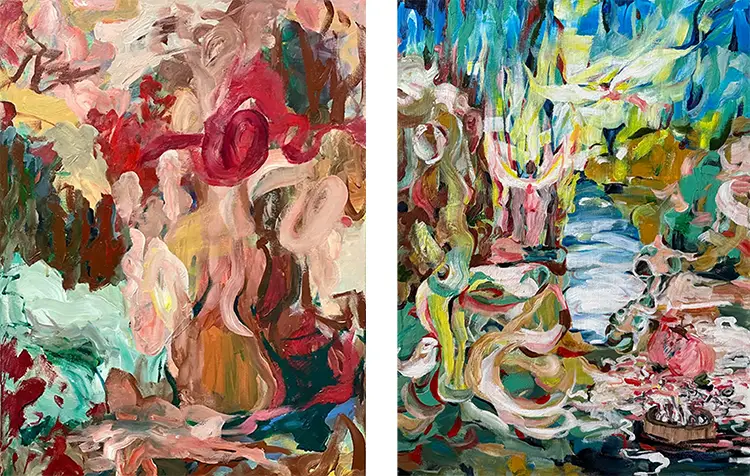
Yanhua Feng: Abstraction as Embodied Intelligence
Feng’s artistic evolution unfolded without rigid intention. Rather than pursuing art as a careerist decision, she allowed it to arise naturally as her most authentic form of communication. At the heart of her approach lies a commitment to abstraction, which she regards not as a retreat from the real but as a means to return to human essence. Abstract painting, for Feng, is deeply physical and emotional. It bypasses narrative and symbolism in favor of immediate sensation and the intuitive movements of the body. Through each stroke, she aims to transmit the vitality of lived experience—a counterpoint to the hyper-rational structures that increasingly define contemporary life.
In this context, she often reflects on the dual connotations of the term AI: Artificial Intelligence and Artistic Intelligence. Where the former prioritizes logic, efficiency, and data, the latter insists on sensation, vulnerability, and the immeasurable depth of human feeling. Feng sees the rise of AI not as a threat, but as a mirror that sharpens the relevance of art as embodied perception. Machines may replicate aesthetic forms, but they cannot replicate the intuition, doubt, and presence required to make them meaningful. Her work insists on this difference—not through resistance, but through clarity of purpose. Each painting stands as a testament to the irreplaceable nature of human touch and sensitivity.
This sensitivity is further underscored by her embrace of impulse and improvisation. Abstraction offers her a space where thought and motion become one, where color becomes sensation and gesture becomes language. In this process, the studio transforms into a site of discovery rather than execution. There are no fixed outcomes, only continual becoming. Through this approach, Feng not only redefines abstraction as a method but as a mode of being—fluid, responsive, and intensely human.
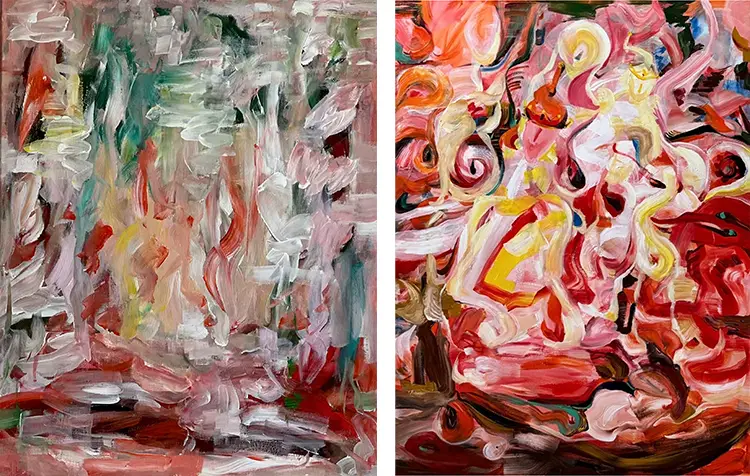
Between Struggle and Flow: Inspirations That Resonate
Feng’s artistic lineage draws strength from figures who, like her, found liberation within tension. She cites Willem de Kooning and Peter Paul Rubens as enduring influences, each embodying different aspects of her aesthetic and conceptual concerns. From de Kooning, she absorbed the restless energy that arises when control meets chaos, a dynamic that shapes her own work’s expressive charge. His canvases, which feel like physical encounters between body and paint, revealed to her how struggle could be beautiful, and how emotion could be mapped through movement rather than narrative.
Rubens, in contrast, offered a celebration of life’s vitality, one grounded not in divine order but in the richness of human experience. His works are imbued with rhythm and intensity, elements that Feng channels into her own compositions. She admires how his paintings honor the interconnectedness of people and nature, pulsing with a kind of theatrical grace that never feels static. These historical touchstones allow her to see her practice not as isolated but as part of a broader continuum where artistic freedom is born from complexity.
Beyond these canonical influences, her own biography provides a more personal form of guidance. Living across multiple cultures has taught her the value of undefined spaces—the places between identities, languages, and systems. Rather than striving for fixed meaning, she leans into ambiguity, trusting it to generate more expansive interpretations. This disposition has become central to her ethos as an artist. For Feng, the point of art is not to deliver closure but to sustain questions. In this space of inquiry, the viewer becomes an active participant, free to find their own emotional and intellectual connections.
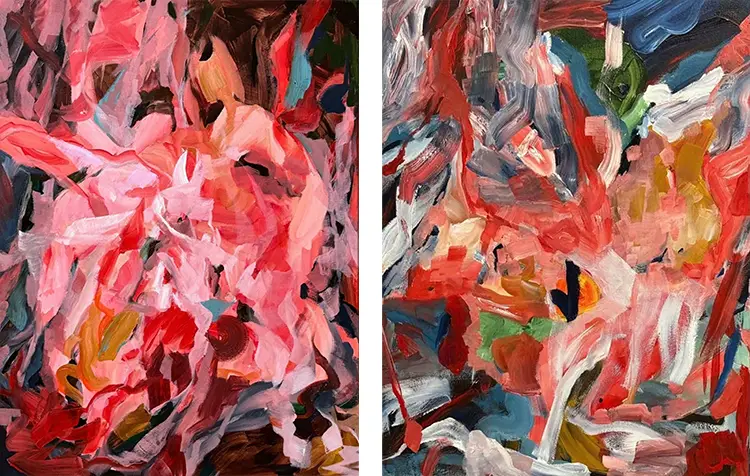
Yanhua Feng: The Unfolding Practice of Uncertainty
One of Feng’s most meaningful works, Interlace, embodies the visual and conceptual themes that animate her wider practice. At first glance, the canvas presents a surge of layered color, where abstraction and figuration momentarily cohere before dissolving. Upon closer inspection, traces of bodies and emotions become visible—entwined gestures that suggest both conflict and intimacy. Created with acrylic on canvas, the piece demonstrates her affinity for a medium that accommodates revision, spontaneity, and movement. Acrylic dries quickly, which aligns with her intuitive process and her resistance to perfection. It allows her to respond in real time, making every mark a reflection of an evolving state of mind.
Interlace also serves as a visual meditation on connection. It explores the tensions and harmonies that arise between people, between past and present, and between inner states and external realities. The composition suggests that relationships—whether personal or societal—are rarely fixed. Instead, they unfold in waves, shaped by emotional turbulence as much as by clarity. The piece resists easy interpretation, inviting viewers to sit with contradiction and unresolved energy. Feng connects this idea to Plato’s Allegory of the Cave, suggesting that what we perceive is only a flicker, a shadow of something deeper. In her view, art serves a similar function: not to expose a single truth but to gesture toward the invisible light that flickers between awareness and perception.
This philosophical lens informs the direction of her upcoming work, which centers on the creative possibilities of uncertainty. Her daily studio practice begins in stillness—moments of quiet designed to heighten her sensitivity to the present. From this state, she moves into action, letting color and movement guide her rather than any predetermined plan. Her forthcoming series continues to reject certainty, which she describes as a silent force that suffocates artistic vitality. Instead, she embraces unpredictability, trusting it to lead to new emotional frequencies. With this body of work, Feng aims to construct spaces where viewers can pause, breathe, and feel without the burden of conclusion—spaces that prioritize resonance over resolution.
